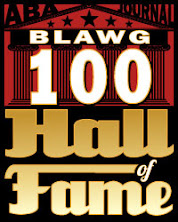Friday, August 11, 2017
IPSC Breakout Session IV
Friday, November 07, 2014
The Eureka Myth: Reputation
More subtly: it’s the meaning of progress, rather than the nature of evidence to be deployed, that requires interrogation. But that seems to require not a recalibration of IP but rather a reassessment of what it means to gather data when you’re trying to justify something. It’s very hard to get rid of the incentive story by looking at evidence.
Saturday, February 08, 2014
The ecstasy of influence
Wednesday, November 28, 2012
Okay, very obvious joke
Monday, November 05, 2012
Appropriation, artist
Sunday, October 28, 2012
What does "counterfeit" mean for books?
Similarities such as "Both reports dedicate a chapter to transportation. Both illustrate key points with a photograph of a big rig, shot low to the ground from the driver's side" couldn't support a copyright claim, since the original is a work of the federal government. And it's unlikely that many concepts of authors' rights/personhood/attribution rights would cover the government, though I suppose they could. But does "addendum" (plus the other similarities, if they can properly be considered) communicate a false message that it comes from an official source in a way that would survive a Rogers v. Grimaldi examination?
Thursday, July 19, 2012
Saturday, May 05, 2012
Roflcon Keynote: Supercuts
Sunday, October 03, 2010
Variances in attribution norms
HT: Francesca Coppa.
Thursday, December 17, 2009
A different take on the attention economy
Wednesday, September 30, 2009
Authenticating Warhol
Sunday, June 21, 2009
A fire station of unknown origin
The parties, who had worked together in a previous incarnation and apparently ended up in a nasty split, fought over advertising claims related to sixteen architectural designs shown at industry trade shows, in general marketing/PR materials, and on the internet. They compete in a specialized industry, the design of fire houses; each project is worth six or seven figures. Advertising that a company has received an architectural award and that it has performed previous architectural work are useful ways to attract new clients. A large percentage of new business comes from the handful of trade shows each year that are attended by fire chiefs, commissioners, and other fire personnel. These customers are likely to be confused if two different firms claim to have received the same award or performed the same work.
The court reviewed §43(a)(1)(A) and (a)(1)(B). (I bet you’re thinking, correctly, that Dastar precludes an (a)(1)(A) claim, but stick around—(a)(1)(A) will retain relevance.) The opinion identified three ways of proving deceptiveness under (a)(1)(B): survey evidence, evidence of actual confusion, and “argument based on an inference arising from a judicial comparison of the claims and the context of their use in the marketplace.” A welcome result, but not one that’s very common, to say the least!
Here, there was neither survey evidence nor actual confusion evidence, but the court nonetheless went on to consider “whether the ordinary, prudent customer in the marketplace would likely be confused,” using the Polaroid factors. The court said these factors were “well-known and need not be recited in their entirety here,” and “can be enlarged or diminished depending on the facts of the particular case” because the court’s evaluation is not mechanical, but should focus on the ultimate question of confusion. (Notice how not reciting the factors helps obscure that the factors are designed to assess trademark infringement, not false advertising in general!) I like how the court thinks; I am increasingly of the opinion that the multifactor confusion test, though it has its weaknesses, is superior to the rigid and ultimately insupportable falsity/misleadingness distinction.
Applying this method, the court found that the Polaroid factors favored a finding of likely confusion for 14 designs, which the court proceeded to order credited in particular ways. The confusion with which the court was concerned covered primary responsibility for designing the architectural works and/or receiving architectural awards. The modified Polaroid factors played out as follows: The parties’ products are similar in quality and consumers are relatively sophisticated. However, the other factors outweighed these considerations: the strength “of the moving party’s claim to be responsible, or largely responsible, for the architectural design and/or award in question”; the close similarity between the parties’ representations that they were responsible for the designs/awards; the identity of services and advertising channels; the parties’ intent to continue making the same claims; the testimony of both principals that confusion was likely; and the parties’ lack of good faith. (While the strength of the claims makes some sense, comparing mark strength to the degree to which the claim at issue is clearly false, the similarity of the parties’ representations will rarely be relevant in a false advertising case. Applied to false advertising, the exact Polaroid factors will often be poor fits—as the court partly acknowledged by modifying them.)
The court required attributions to be conspicuously placed near the relevant claims, in a typeface at least as large as the claims, with no additional language or competing attribution (including claims by one party to have been part of the “design team,” claims to have been “in charge of design,” or references to “the firm he founded”). The attributions had to disclose the architect of record, though in some cases that had to be accompanied by “now known as.”
Friday, April 10, 2009
Too much attribution?
Saturday, May 24, 2008
Wednesday, May 21, 2008
Reverse passing off claim fails as false advertising
Landrau v. Solis-Betancourt, -- F.Supp.2d --, 2008 WL 2091125 (D.Puerto Rico)
Some background here. The court found that the homeowners initially contracted with Solis-Betancourt to design a renovation, then decided to build a new house. The homeowners gave defendant Solis a “rough conceptual sketch” of the configuration of the new house, and then they worked together to refine it. After that was done, the homeowners hired Landrau and her firm. The homeowners gave Landrau a sketch of the new home, though there’s a factual dispute over whether Landrau was aware of Solis-Betancourt’s involvement at this point.
More basically, the parties disputed who was the “creative force” behind the architectural design. Solis maintained that Landrau was only hired to provide “technical working drawings” necessary to get building permits. There was evidence that Solis reviewed and modified Landrau’s drafts; modified the building authority-approved plan; and continued working on the project after the permits were issued, whereas Landrau did not. Landrau, however, introduced evidence that both she and the construction manager believed that Solis was only responsible for interior design or decoration, not architecture, and that the design changes during construction were merely “cosmetic.” (These details of the factual dispute make clear that Dastar precludes this claim under §43(a)(1)(A). The “creative force” question is precisely the kind of reverse passing off claim the Court meant to preclude unless it could successfully be pled as a false advertising claim.)
As is often the case, the practicalities of business trumped legal certainty: Landrau didn’t have a signed written contract. She sent the homeowners a letter with a fee proposal and an attached American Institute of Architects form contract which discussed architectural services. But the homeowners didn’t sign the fee proposal or the form contract. The parties dispute whether there was an oral agreement to the contract.
The court first asked whether this was a §43(a)(1)(A) or §43(a)(1)(B) claim, because the plaintiffs’ arguments were ambiguous. (a)(1)(A) covers “false representations concerning the origin, association or endorsement of goods or services (‘false association’ or ‘false designation of origin’); and (a)(1)(B) covers false advertising. Plaintiffs didn’t specify, but did call their claim one for “reverse palming off.” This, the court concluded, occurs “almost exclusively” under (a)(1)(A). In addition, plaintiffs failed to allege that the reverse passing off occurred in commercial advertising or promotion, as required for (a)(1)(B). The court declined to credit plaintiffs’ “revisionist history” in which they’d implicitly alleged that the Architectural Digest article was commercial advertising. Nonetheless, it analyzed the false advertising claim on the merits, as plaintiffs desired (plaintiffs having presumably realized their unsurmountable Dastar problem with respect to (a)(1)(A)).
The unsurmountable problem with a false advertising claim here was different: commercial advertising or promotion. The Architectural Digest article was not commercial speech. It proposed no commercial transaction. Solis-Betancourt didn’t pay AD for the article. Though a partner in Solis-Betancourt proposed that AD do an article on the house, and Solis-Betancourt may have hoped to attract clients (and may have succeeded in doing so) as a result of the article, that’s not enough to make the article commercial speech. The court quoted Croton Watch Co., Inc. v. National Jeweler, 2006 WL 2254818 (S.D.N.Y. Aug.7, 2006): “A plaintiff cannot adequately plead a violation of the Lanham Act by simply alleging that defendant caused a journalist to write the article, the content of which plaintiff finds objectionable.”





